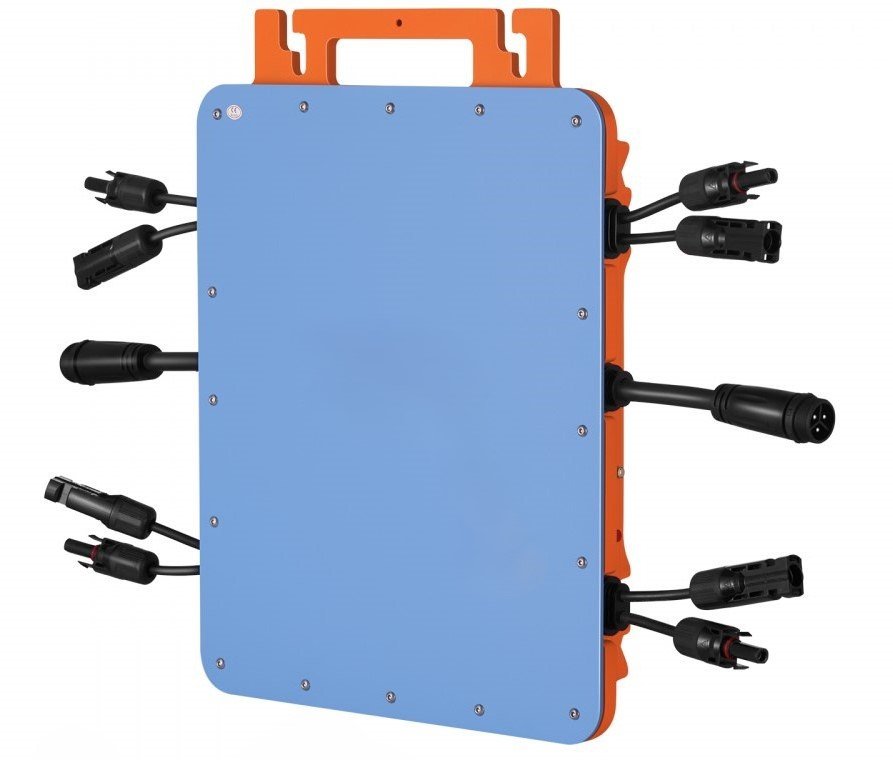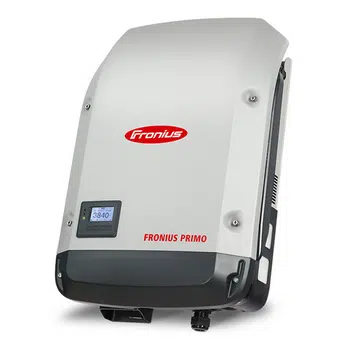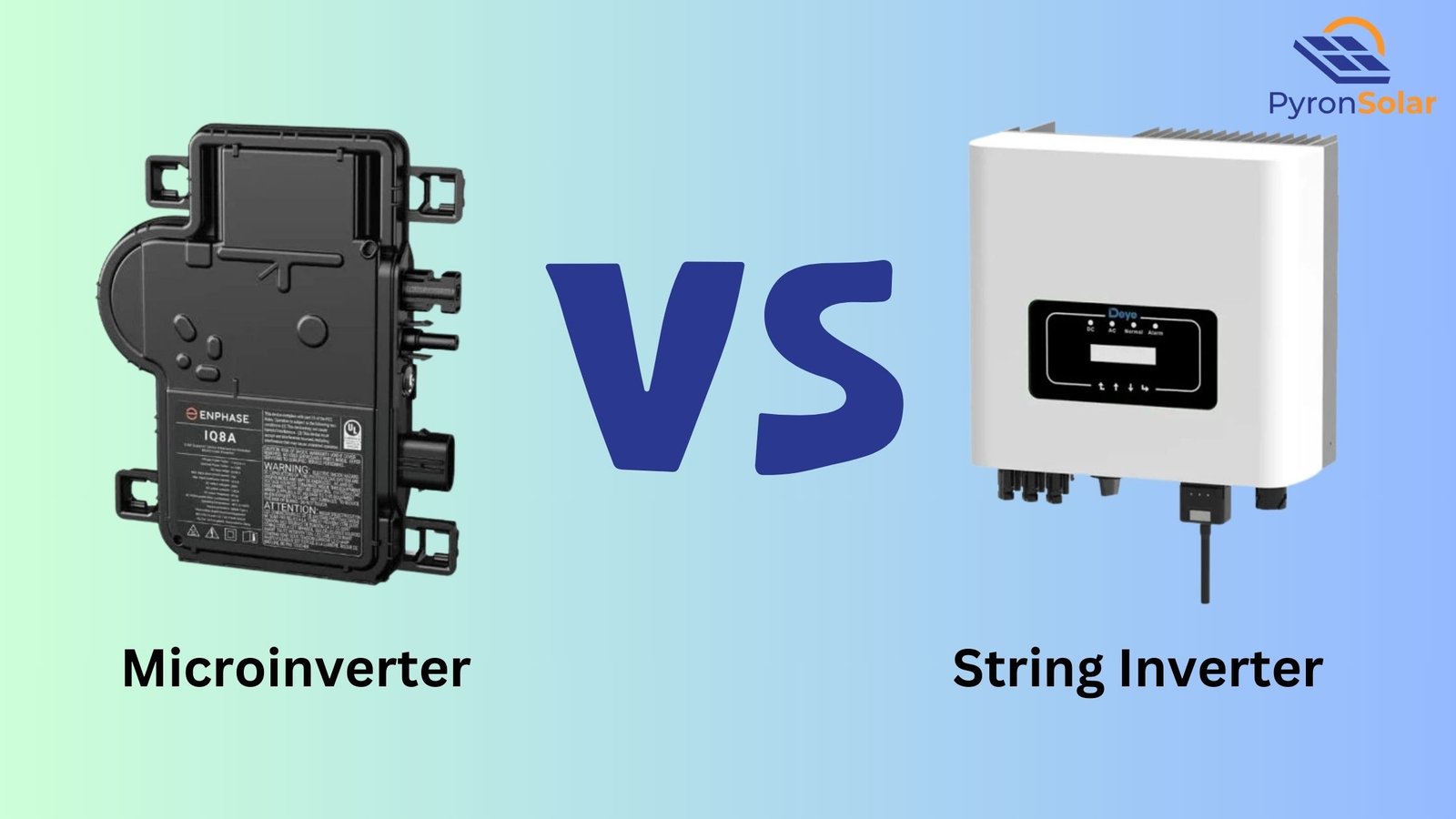Solar inverters are essential components that play an important role in converting solar panel-generated DC power to AC power, which can be used for home appliances. Inverters are essential for solar panel installation since the DC power produced by the PV modules cannot be used directly to run home appliances.
The chosen type of inverter will directly affect the solar system’s cost, efficiency, and monitoring capability. There are major 3 types of solar inverters — string inverters, optimized string inverters, and microinverters.
The basic types of inverters used in residential solar systems are string inverters, having 10 to 15 years of lifespan, and are much more affordable and simpler to install than microinverters. Whereas, microinverters are costlier than string inverters, but it comes with the advantage of ‘panel-level monitoring’ and a more extended lifespan of up to 25 years. Hence, these microinverters are well-suited for complicated installations under fluctuating sunlight conditions.
In this guide, you will understand the difference between microinverter and string inverter, pros and cons of string inverters and microinverters that vary according to several factors such as dimensions, maintenance, scalability options, and panel layout.
Microinverter vs String inverter: What’s the difference?
One of the main differences between microinverters and string inverters is the location and timing of DC-to-AC energy conversion.
Typically, microinverters are attached to each solar panel and convert DC to AC power at every individual panel itself. Whereas, string inverters are placed centrally and convert the combined DC electricity from multiple panels into AC electricity.
What are Microinverters?

The main difference in the operation is that microinverters are connected directly to each solar panel and convert the electricity from the source it was produced. Whereas string inverters are installed on your house and convert electricity from solar panels at one common point.
Especially, in certain situations where you have a complex roof design or partial shading, microinverters can prove to be beneficial. These inverters can operate at the panel level and don’t require power optimizers to perform the role of rapid shutdown. Here are also more details about microinverters.
Pros and Cons of Microinverters
The pros and cons of micro inverters are highlighted below in a tabular form:
| S.No | Pros | Cons |
| 1. | Easier and more affordable to include extra panels | Highly expensive when compared to string inverters and power optimizers |
| 2. | Helps to monitor the performance of an individual solar panel | Difficult to repair and complex maintenance process |
| 3. | Higher warranty period | More points of failure |
| 4. | Independent functioning of panels helps to maintain higher output even if one panel is shaded | Possibility of heat sensitiveness |
| 5. | Ability to perform rapid shutdown and allow easy system expansion |
What are String Inverters?

The DC electricity from each solar panel in a string flows through the wiring connected to the inverter, which is then converted into AC electricity. This type of inverter is either installed on the ground or mounted on the roof and connected to panels via cables. The additional energy can be used to power your home or sent back to the grid known as the Net Energy Metering (NEM).
Residential buildings and small-scale commercial solar energy systems use string inverters that can be installed on simple and unshaded roofs. There is a much more about string inverter you should know.
Pros and Cons of String Inverters
The advantages and limitations of string inverters are tabulated below in detail:
| S.No | Pros | Cons |
| 1. | Easy troubleshooting features | Less efficiency due to shading or single-panel issues |
| 2. | Lower initial cost | Less warranty period compared to other types of inverters |
| 3. | Simple Design | Additional investment to add more panels and equipment required to handle rapid shutdowns |
| 4. | Can be integrated with power optimizers | Inverter issue affects the entire system. |
| 5. | Requires fewer parts for monitoring | Not suitable for roofs with partial or complete shading issues |
Factors to Consider Before Choosing between Microinverters and String Inverters
Before choosing between microinverters and string inverters, you must consider important factors such as performance, size, maintenance, longevity, cost, expansion, and panel layout.
Performance
The comparison of microinverter vs string inverter under optimal conditions has performed equally well. However, microinverters are a promising technology with highly efficient performances, considering the limitations of string inverters to perform in a few circumstances.
Also, microinverters perform well in shaded conditions by minimizing the effects of partial shading and variations in panels, which results in high energy outputs. Whereas, string inverters output gets reduced due to the partially shaded single module connected in a series string.
String inverters function effectively with uniform panel orientation since all panels face the same direction and receive equal sunlight exposure. In the case of several roof panels or fluctuations in panel orientations, microinverters are the ideal choice they offer higher flexibility and maximize energy production from every single panel irrespective of their positioning.
Size
The physical size of a string inverter is approximately 30 inches tall, 20 inches wide, and 8 inches deep with 50 pounds in weight, which can be installed next to your utility meter. However, the large and bulk nature of this inverter can make it challenging for installation. Also, oversizing can result in increased cost and inefficiencies, and undersizing can cause clipping, leading to energy losses.
Microinverters are smaller than string inverters, but they are slightly larger compared to a junction box on the solar panel weighing around 2 to 4 lbs. They can be easily carried and installed directly on each solar panel in an adjacent manner. As a result, the AC voltage drop is reduced and needs more inverters to deliver the minimum energy requirements.
Maintenance
String inverters require only fewer components and can be easy and less expensive to maintain and replace if required. But, all the panels should have a similar output from your solar system and troubleshooting can be time-consuming. One advantage is that the central inverter needs to be monitored to ensure easy maintenance and the replacement process is straightforward and takes just 1–2 hours.
Contrarily, microinverters require more labor which can prove to be costly since each panel has its own inverter. In terms of the bottom panel arrangement, microinverters gain an advantage for easier installation, but the maintenance process becomes complicated, which can be simplified only through individual panel monitoring. The replacement process involves gaining access to the roof, detaching and reconnecting the wiring, withdrawing the old microinverter, unplugging electrical connections, and reinstalling the new microinverter.
Life Expectancy
Typically, string inverters have a shorter lifespan of upto 12 years and high-quality brands might provide upto 20 years or more. Whereas, microinverters can be acquired with a longer lifespan and warranty period of upto 25 years.
The lifespan of an inverter plays a crucial role in determining the overall value and reliability of a solar power system for a smooth DC-to-AC conversion process as well as to satisfy the safety standards and grid compliance regulations. Therefore, it is important to assess the inverter’s reliability and failure rates before choosing a system.
Cost
String inverters have lower upfront costs with approximately $1.00 per watt. When considering the long-term cost, string inverter installers typically charge per-panel basis to calculate the installation price as listed below:
- 5 kW system costs $5,000.
- 10 kW system costs $10,000.
- 20 kW system costs $20,000.
Microinverters have higher upfront costs ranging between $1.30 per watt to $2.00 per watt. Based on the size of the system, the cost varies as mentioned below:
- 5 kW system costs $10,000.
- 10 kW system costs $13,000.
- 20 kW system costs $26,000.
String inverters with a 10-12 year warranty must be replaced at half-life of the panels which might cost an additional $500 to $600 to your overall system cost. Despite the higher initial cost, microinverters provide long-term savings due to higher efficiency and flexibility, with a 25-year warranty, adding value to your solar power system.
Also, traditional string inverters will check the potential electricity production of each panel. This happens if one solar panel generates less electricity, the output is limited for all panels connected in the same string. Whereas microinverters operate in a parallel circuit and don’t face any issues.
Expansion
Suppose you’re planning to expand your solar system in the future, microinverters are the best option since they offer higher flexibility where the panels can be integrated with smaller system modifications that allow you to add panels one by one. String inverters undergo a complex process of system redesigning or inverter replacement, thereby requiring extra panels to be compatible in terms of voltage with the original panels.
Certain key factors should be considered for future system growth when choosing an inverter type such as:
- Size and scalability: The system size might influence the size of your inverter, multiple units, and expansion options.
- Compatibility: Inverter should be compatible with the specifications of your solar panel and any mismatches can lead to diminished efficiency or damage to your system.
- Efficiency ratings: The higher efficiency ratings indicate the amount of generated energy available for use, thereby increasing the overall productivity of your inverter solar panel system.
- Features and Technologies: A few inverters are featured with interesting technologies such as advanced monitoring systems that help you to track your energy production and consumption in real-time.
- Cost and Warranty: It is important to find an inverter that has a perfect balance between cost and quality. This is because highly reputed branded goods provide longer warranties to highlight the manufacturer’s commitment towards their product and guarantee you peace of mind.
- Installation and Maintenance: The installation should be done in such a way that it is easily available for maintenance or repair.
- Certification and Compliance: Verify that the certified inverter meets all required standards and regulations, which is proof of safety and reliability.
Panel Layout
In terms of system design, string inverters are less flexible and aren’t suitable for complex roof layouts, therefore making the installation process possible on a wall near a solar array or standalone device. If you want to add additional panels in the future, the entire inverter must be replaced to handle more power.
Despite microinverters having higher flexibility and performance, installation processes and maintenance remain a huge concern. Also, it is important to connect the microinverter to each solar panel, which requires a lot of time and labor in the system setup. However, these inverters are still preferred for irregularly shaped roofs or areas with excessive shading.
Microinverters vs String Inverter: Which is Right For Your Solar System?
Overall, the ideal scenarios for choosing a string inverter over a micro inverter and vice versa depend on certain factors such as system size, shading, budget, and future expansion plans.
Microinverters are suitable for small, difficult, or shaded rooftops, especially in situations where shading or complex roof layout is a major concern. Although these inverters tend to be expensive, you can plan for long-term benefits due to their ability to achieve maximum efficiency and output.
Conversely, string inverters deliver higher performance on larger and unshaded roofs that face south direction and are suitable for simplistic installation with exposure to abundant sunlight. However, if one panel is shaded or underperforms, the other panels’ performance in the string gets affected and produces the same output as the shaded ones. At the same time, string inverters are less expensive when compared to microinverters, and adding more panels can be a complex process and might require an additional or new inverter.
Finally, choosing the best type of inverter purely depends upon your circumstances and requirements and it is recommended to consult with a solar energy professional to assist you with the best option for your solar system.
Ray is an avid reader and writer with over 25 years of experience serving various domestic and multinational private and public energy companies in the USA.

